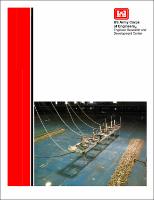Please use this identifier to cite or link to this item:
https://hdl.handle.net/11681/7596| Title: | Laboratory study of hydrodynamics near absorbing and fully reflecting jetties |
| Authors: | Seabergh, William C. Lin, Lihwa Demirbilek, Zeki |
| Keywords: | Coastal inlet Environmental data Jetties Laboratory wave measurements Longshore current circulation Wave-induced currents Coastal Inlets Research Program (U.S.) |
| Publisher: | Engineer Research and Development Center (U.S.) |
| Series/Report no.: | Technical report (Engineer Research and Development Center (U.S.)) ; no.ERDC/CHL TR-05-8 |
| Abstract: | This physical model study of absorbing and reflecting jetties at coastal inlets was conducted to provide data sets that would aid in the calibration and verification of numerical wave models. The study was performed in the Coastal Inlet Research Program’s (CIRP) idealized inlet experimental basin at the U.S. Army Engineer Research and Development Center (ERDC), Coastal and Hydraulics Laboratory (CHL), Vicksburg, MS. Safe navigation, sediment transport into navigation channels, and shoreline erosion are all concerns at coastal inlets and are related to the transformation of waves as they change direction and height due to complex bathymetry and coastal inlet structures. The idealized inlet physical model, created for inlet studies, provided a facility in which to make wave measure- ments of height and direction and the associated wave-generated currents in enough detail to document the wave height and current variation in a region with complex interactions. Measurements of wave information included use of wave rods for wave height and acoustic Doppler velocity sensors for wave direction and current. Qualitative dye photographs and videos were also obtained. Wave height and velocity measurements were collected both upcoast of the jetty and between parallel jetties for a number of waves representative of tidal inlets. The composition of the jetty was designed to portray the extremes of an inlet jetty – a jetty that fully reflects the incident wave toward the upcoast shoreline adjacent to the jetty, and an almost fully absorbing jetty, which reflects very little energy. These two extreme conditions created two different circulation patterns associated with each jetty condition. The nearly fully absorbing jetty setup permitted the wave-generated longshore current to approach the jetty and essentially be deflected seaward ninety degrees, along the jetty. The waves fully reflecting from the jetty created a clockwise circulation cell at the intersection of the jetty and the shoreline. This cell was large enough to deflect the offshore movement of littoral currents a significant distance upcoast rather than approaching the base of the jetty before deflecting seaward as for the absorbing jetty setup. |
| Description: | Technical Report |
| Gov't Doc #: | ERDC/CHL TR-05-8 |
| Rights: | Approved for public release; distribution is unlimited |
| URI: | http://hdl.handle.net/11681/7596 |
| Appears in Collections: | Technical Report Technical Report |
Files in This Item:
| File | Description | Size | Format | |
|---|---|---|---|---|
| CHL-TR-05-8.pdf | ERDC/CHL TR-05-8 | 3.61 MB | Adobe PDF |  View/Open |